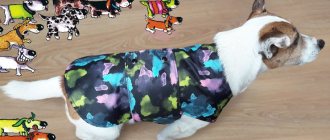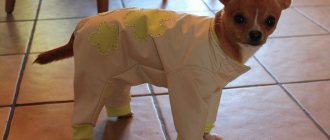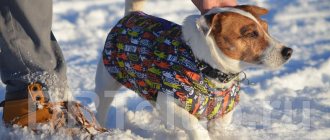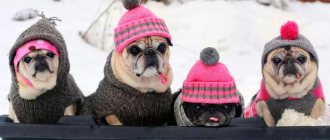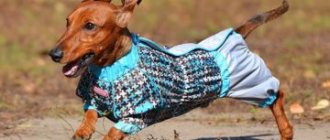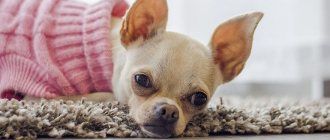Sewing clothes for dogs is not a newfangled fad of modern dog breeders. Many veterinarians talk about its necessity. For miniature breeds with fine hair, clothing is guaranteed protection from the cold. Therefore, an insulated jumpsuit for a dog, made according to a simple pattern, is one of the most important components of a dog’s wardrobe. In addition to clothing, dogs also need shoes to protect the skin on their paws from hazardous substances that are sprinkled on roads in winter.
All this, of course, can be bought in the store. But will the finished average size take into account all the anatomical features of a particular dog? Sometimes the sleeves are short, sometimes the collar is wide and allows the wind to pass through, sometimes the armhole is narrow and the clothes rub against the armpits. But there is a way out. You need to sew clothes for your pet with your own hands.
Let's take a closer look at the main stages of making clothes.
Material selection
When choosing a material, you need to take into account the time of year for which the clothes are sewn, the age of the animal, the quality and composition of the fabric. For demi-season clothing, we choose breathable material without a greenhouse effect. For protection from rain - waterproof fabric. For young and active animals, the strength of the material is important. For any clothing, indelible coloring and hypoallergenicity are also important.
The materials used for insulation can be different - padding polyester, padding polyester, fleece. Lining fabrics must be smooth. Suitable viscose, satin, twill.
Clasps
When choosing a model, keep in mind that the most optimal place for the fasteners is the back. It's convenient and safe. Velcro, buttons (suitable only for small dogs; for large and medium-sized dogs, the clothes will unfasten when running), ties made of ribbons and laces, buttons, zippers with a limiting strip to prevent hair from getting into the teeth, and elastic bands are used as fasteners.
When sewing clothes for an animal, first of all you need to think about comfort, so we must ensure an ideal cut and high-quality seam processing. The anatomical correspondence of the pattern to the structure of the animal will be higher, the more accurately the necessary measurements are taken.
How to take measurements from a dog
The animal must stand upright.
When taking measurements, the centimeter should be pressed quite tightly to the dog’s body, but with the possibility of turning. Take a close look at the picture below, indicating the required measurements.
To sew clothes for a dog you need to measure:
- back length (1);
- chest volume (2);
- neck volume (3);
- waist size (4);
- distance from neck to front paws (5);
- front paw volume (6);
- sleeve length (7);
- hind paw volume (8);
- leg length (9);
- distance to the male organ (10);
- distance between the front paws (11);
- distance from front to back paw (12);
- distance between ears (13);
- horizontal head circumference (under the ears) (14);
- vertical head circumference in front of the ears (under the chin) (15);
- vertical head circumference behind the ears (16).
Now let's figure out how the basic pattern of overalls for a dog is constructed. Based on it, you can perform modeling, creating different styles for any time of year.
Step-by-step construction of a pattern
When constructing the pattern, the measurement designations shown in the photo were used.
General table of measurements with explanation - see below.
Let's decide on the overall dimensions. They are determined by the length of the back and the height at the withers. In the upper left corner of the sheet we mark point O. From it horizontally to the left we put the length of the back, we put point H. Down vertically we put the height at the withers, we put point B. We draw a horizontal line.
Horizontally to the right we put aside half the difference (Shg - Shpl), put point C. Draw a vertical straight line from it down.
From the bottom horizontal line, measure upward the distance to the collar in front, put point G. The lateral width of the overalls will be determined by the section of the pancreas. Its value is equal to half the difference in chest circumference and width between the paws (RV = Og - Shpl). The PO value is the distance from the collar to the line of the beginning of the front paw. We draw a smooth line for the neckline from point O to point G.
Let's start shaping the belly line. In the center of the segment PN we place point M. From it we lower the perpendicular, and put on it the value MF1 = 1/2 (From - Shpl). From point G1 at an angle of 45 degrees, draw a straight line until it intersects with the horizontal line drawn through point G.
Let's calculate the width of the front leg trousers at the bottom. To do this, add 4 to 6 cm to the girth of the wrist of the front paw for a loose fit (the amount depends on the type of fabric and processing method). We distribute the resulting value (=ЗЗ1) relative to point B. To the left we put 1/3 of the value (= ВЗ), to the right – 2/3 (= ВЗ1). We carry out sections GZ1 and ZZh.
We will provide a dart for a more precise fit of the product and maximum comfort for the animal in motion. From the point of intersection of the segment Z1G with the horizontal through the point G, we set the dart width upward to 3 cm. The depth is counted as three widths, that is, 9 cm. We extend the segment GZ1 downward by 3 cm, keeping the length of the trouser leg unchanged. We draw a smooth bottom line.
We draw down the vertical HH1. We mark the segment H1M1, equal to the height to the base of the tail. We connect point M1 with the middle of the segment NM.
The width of the wrist for the back leg P1P2 is equal to the same size for the front leg ZZ1. Its distribution is also similar: Н1Р1 = 1/3 Р1Р2, Н1З2 = 2/3 Р1Р2.
At the intersection of the horizontal through point ZH1 and the vertical through point P1 we place point M2. From it to the left we measure a horizontal segment equal to Н1Р2, put a point M21. From it we lower the perpendicular down to the bottom.
We draw a straight line through the center of the segment NM and point M2, extending it until it intersects with the vertical drawn down from point M21. We place the SK point at the intersection. This is the mark for the hock joint. After trying on, you will need to adjust the location of this point if necessary. We carry out segments P1SK and SKM2. We connect points P2 and G1 with a concave pattern line.
We draw segment M1M2. Above it we draw a convex line, repeating the shape of the dog. For a better fit, we will make a tuck. When sewing, it can be transformed into an assembly. Along the drawn line from M1 we set aside 3 cm, then the width of the dart is 3 cm. The depth of the dart is twice its width plus from 1 cm to 2 cm, that is, from 6 to 8 cm. We draw the dart.
From point P1 we extend the straight line by 3 cm (dart size) to maintain the length of the trouser leg. Draw the bottom edge of the trouser leg as shown in the figure.
Next, let's start cutting out the abdomen. Draw a rectangle with a width equal to the width between the front legs. The length of the rectangle is equal to the sum of the lengths of the segments indicated in red on the overalls pattern. We divide the rectangle into three identical parts and expand them by the amount indicated in the drawing. Draw the convex contours of the part. When making this pattern, you need to take into account the sex of the animal and make the appropriate length of the pattern.
Using the main pattern, we re-cut the pattern for the inside of the pants of the overalls. It copies the bottom part of the main pattern.
Clue
After making the pattern in full size, check that the lengths and widths correspond to the actual measurements.
Using this pattern, it is advisable to sew a mock-up jumpsuit from waste fabric and, if necessary, adjust the fit. We then make these adjustments to the drawings.
Taking measurements from the dog
Before you sew clothes for your pet, you need to take his measurements. These are the basic parameters of the body, which are then applied to the fabric. Moreover, the recommendations are valid for all breeds, from a small toy terrier to a large great dane.
During measurement, you need to study 2 rules in detail:
- The measuring tape should be pressed tightly against the body. Not just touching the fur, but tightening the skin, but without pressing.
- You need to add a few centimeters to the results obtained so that the dog can turn around calmly. This is especially true for breeds that cannot sit still.
After this, you just need to transfer the resulting replacements to the drawing and translate it into fabric.
So how do you take measurements from a dog? Need to measure:
- Back length, from neck to tail root;
- Volume of the sternum and cervical region;
- The volume of the waist belt together with the distance from the neck to the beginning of the hind legs;
- Girth of forelimbs;
- The length of the sleeve with the girth of the forelimb;
- Length of trousers;
- Length from genitals;
- The gap between the forelimbs and the gap between them and the hind limbs;
- Interaural distance;
- The volume of the head below, above, in front of the ears.
The tail is taken into account very rarely, for example, when sewing a designer jumpsuit. The only thing is that a hole or a small sleeve is cut out for the tail.
Dog clothes are usually sewn not only based on parameters. If the dog is a hunting breed, they need to move a lot, so things should always be looser for them.
How to sew a jumpsuit for a Labrador?
We can sew any clothes for our pets ourselves. There are a lot of patterns, but they are all quite simple. I think that when creating a jumpsuit it will be important for us to choose a good fabric. Much depends on the fabric - the beauty of the overalls, its fit.
I found several patterns. I’ll say right away that they are all similar to each other.
It doesn’t matter what kind of dog the overalls will be for, the sizes can be easily changed.
For a Labrador, you can sew a jumpsuit with or without a hood. You can sew it with short legs, you can sew it with long legs - to your taste.
The overalls can be assembled from two items - pants and a jacket.
I really liked this idea:
It seems to me that this option is very suitable for a Labrador.
You can also create a pattern yourself. We take the finished pattern as a basis. This one:
Then we measure the back of our pet - from the tail to the collar (the collar is not tight). Have you measured it? Now we divide the result by eight. We have a square size for the pattern.
We build a pattern by simply modernizing the finished one. Nothing complicated if you work on graph paper.
Cut it out and transfer everything onto the fabric. We make our blanks, allowances are also needed. We sew, we try on. I’ll say right away that if the overalls are wide and large, you can always make additional lines).
P.S. You can also find a lot of advice
Dog clothing patterns
Patterns of clothing for dogs with explanations can be found below. There is no need to invent anything - just take existing proven ideas and do everything according to the instructions. If your dog is tame, a dog bag may be a better choice.
Simple type blankets
Blankets are the most common clothing for dogs. In fact, this is just a form, and it can be made from any material. So, for example, there are options:
- Winter. They are made of dense, warm but breathable material that can protect against the cold. As a rule, they are lined with fleece or staple.
- Autumn. Made from moisture-resistant materials such as rigid nylon.
- Summer. Cotton or linen fabric.
The pattern of a blanket for a dog, regardless of the material, is no different.
For the first time, you can sew a regular cape for your pet, shaped like a triangle or rectangle. The cut includes the withers, the entire back and part of the rear. The rectangular blanket is secured with various fasteners under the neck and on the stomach. The triangular one is passed through from the bottom and fastened at the back. It is convenient to make a loop to attach to the tail. A do-it-yourself dog blanket is simply made from a single piece of fabric. Optionally, it can be supplemented with a fleece lining.
You can also add a hood here. To get rid of possible folds, just add a dart (a back seam that sutures the item at the waist).
The blanket is convenient because such clothes for dogs are easy to make with your own hands and even without a sewing machine. With due diligence, you can sew a whole set in a day.
You can draw patterns with your own hands or take ready-made ones below.
Jumpsuits
How to sew overalls for a dog? These clothes are more complicated and require a sewing machine, but they are much more comfortable for dogs. It completely protects them from the wind, even in extreme cold - it can be worn in the cold in winter.
Overalls for dogs are best made from lightweight fabric with a very durable edge. It is desirable that it has a water-repellent effect.
The whole process can be divided into stages:
- Taking measurements. Based on the parameters above, you need to take the main measurements from the pet. There is a lot to consider here: dog size, breed, coat length, mobility. So, for a small Yorkie, you need to make an allowance, since their hair will not allow them to run and jump in tight overalls. At the same time, shorthaired bulldogs require a large neckline as their necks are much thicker than similar sized breeds.
- Afterwards, to make your own dog overalls comfortable, you need to calculate the allowance. As a rule, for wool dogs it can be up to 2 centimeters. The pattern is transferred to the fabric.
- After cutting, you need to move the seam and try it on the animal. If everything is good, go over the joints with a stitch and you’re done.
At this point, sewing the overalls can be considered complete. The paper should show the back, sternum, neck, belly and, if provided, a hood. Depending on the clothing (fractional or one-piece), trousers can be separate or sewn. You may not even need to take a separate piece of fabric for them.
You can see what the pattern of overalls for a dog looks like below; use ready-made ones.
Dresses
Now it has become fashionable to visit crowded places with your pets. And if this is a social party, a restaurant, a cafe, or even a regular trip to the park, your pet can also be beautifully dressed in a dress. They are made simpler than overalls.
The most common materials for the product: tulle and tulle. They immediately create a somewhat festive atmosphere. They can be decorated with sequins, rhinestones and any other decorations. The easiest way to sew clothes for dogs is from a pre-prepared semi-finished product - a T-shirt. You can make it yourself, or you can take a regular one. Then everything is done according to the following scheme:
- The T-shirt is turned inside out. After this, you need to make cutouts on the stomach and waist.
- The edges are sewn together, and the bottom is better rounded. A drawstring or elastic band is sewn onto the belly.
- A braid is sewn onto the belt.
- The collar can be improved with a handkerchief.
Makeup
Simple
When all you have at hand is a black pencil. We draw a mustache and a nose on the child’s face (painting the entire upper part of the nose) using a cosmetic pencil.
On the forehead or around the eye, draw a circle with the same pencil and paint over it, making a spot.
The makeup is almost ready, if desired, add a tongue by drawing it at the bottom of the lip and painting it with pink lipstick with a brush.
Funny
If you have aqua makeup, then use it to create the look, and it is extremely important that it is anti-allergenic.
Let's draw:
- make the background of the muzzle or the second spot, the muzzle white;
- nose, mustache, freckles, lip, spot on the forehead or around the eye - it is black or dark in color;
- In red we draw a tongue on the lower lip and chin, slightly tilted to the side.
Look at the different variations of doggie costume makeup to create your own using a similar technique.
For those who have never seen face painting on a child, here is a special video tutorial: Video tutorial on face painting of a dog with a tongue: The second lesson with step-by-step execution of dog makeup on a child’s face:
Materials
A do-it-yourself dog costume is made from several parts, otherwise it can be complemented with accessories and decorations.
You will need:
- Fabric membrane. This is a surface material that protects the dog from rain or snow. It is necessary, since the slightest getting wet in cold weather can lead to illness. For example, clothes for a Toy Terrier should be warmer, since they have little fat and hair.
- Lining. Both synthetic and natural materials can be used as lining. Sintepon is universal. Inexpensive, but hypoallergenic insulation that does not cause allergies or irritation in dogs. An incorrectly chosen lining can even cause fur shedding. Felt or fluff is also acceptable, but only if the dog can easily tolerate them.
- Clasps. These can be buttons, snaps, Velcro. But it is preferable to use a regular zipper. Buttons do not tear out wool, but at the same time it is not always convenient to fasten them. The buttons may open if the dog is active or overweight. Velcro quickly becomes clogged with hair and dirt, so they need to be cleaned constantly. The zipper allows you to fasten your clothes tightly and quickly. The only thing is that it can pinch the wool, so it is better to sew 2 pieces of fabric under it.
Additionally, you can sew in various accessories. Often, a dog costume for a boy is sewn by hand with an additional collar. This way it doesn’t get lost and is always on the pet.
Patterns for dogs of small breeds, especially those with smooth hair, should preferably be used with powerful insulation. Synthetic winterizer is not always suitable; here it is better to choose Alpolux. For the off-season, a single-layer fabric is suitable. In this case, you need 2 types of clothing: natural fabric and water-repellent. With them you can not be afraid of heat and rain.
Overalls for Labrador
New categories
- Modern TV stands
- Cosmetic bags The Saem enamel pouch
- Demi desk day 14 02 pink
- Hitachi circular saw c 7ss
- Milardo DonDONSBLCM10
- Echo chainsaw echo cs 4200es 15
- Tom Tailor trousers for girls
- Nike iPod Sport Kit Heart Sensors
- Cam 305
- Women's shorts Summer
- Pastel Ray
- Benq SU964
- Monitors S23C650D
- Krez PL102B DUO
- Radio-controlled quadcopter syma x8hg with barometer and 8mp hd camera
- Retrostyle READING 350 x3
- Hardi fans
- Nikon cameras for beginners
- Hat 686
- Intercom handset UCP 7m
- K7 K-47 Crusoe
- Head massager, acupressure goosebumps
- Clamp holders with tie
- Coloring book antistress magic flowers
- Prospectors decorative plaster bark beetle 25kg
- Refrigerator lg gc b207gmqv
- Sand concrete titanium m300, 40 kg
- Motorola moto x force cell phone
- Double-sided knife for electric planer kp312s makita hss
- Cement tile adhesives "Volma Interior"
- Florentina Fita AV
- Electronic thermometer and dt 624 (d) duckling
- Window lifters ESP VAZ 2104-07 (garnet)
- Kits for removing and installing valve cotters Licota
- Parka AZIMUTH
- Samsung Grand Neo Duos phones
Warm boots
These wonderful, incredibly warm boots are very suitable for such a breed of small dogs as the Chinese Crested. They will perfectly protect her delicate paws from cold snow and sharp pieces of ice. In addition, the soles of dogs very often suffer from chemicals sprinkled by people during icy conditions. And in cloudy weather with light rain, they will be simply irreplaceable.
- We take measurements: place the pet’s leg on paper and trace it along the contour. You should get a small oval - this is the sole;
- Now you need to measure the height of the boots: it can be different, it is better to focus on the hock joint (the Velcro will be under it);
- We determine the width of the boot, it is equal to the length of the sole (oval). On it we mark the places to which Velcro will be sewn;
- Don't forget to leave a seam allowance (1 cm is enough);
- Material: for the sole you need to take a denser fabric, or preferably leather (can be artificial). The boot should be made of water-repellent fabric. Inside the boot you need to place insulation (fleece).
In order not to be mistaken with the size of sewn clothing for a dog, you need to try it on your pet.
Don't forget that not all dogs are accustomed to wearing clothes. Therefore, before trying on ready-made clothes, you need to calm the dog down. Small breed dogs are especially nervous during fitting.
Manufacturing and joining of main parts
We transfer the pattern to the material. To do this, the fabric must be folded in half with the inside out. Place a sample of the side on top. To avoid distortion of the finished product, it is necessary that the back line runs parallel to the grain of the fabric.
We apply the lower insert with a dotted line along the fold. Templates are pinned or basted. We outline the fixed pattern with chalk, taking into account small allowances (0.5 cm - 1 cm) for the seams. When the pattern is transferred to the fabric, we evaluate it visually and cut it out.
To be sure, it is advisable to initially sweep the product by hand in order to try it on your pet. You need to start sewing from the sides. The legs are sewn together first. The darts on the back are placed in the center, stitched lengthwise and crosswise for strength (dart length 7 cm). Next, we connect the sides by sewing on the lower insert, which covers the stomach and chest.
The prepared parts are sewn down on a machine using a linen stitch (used for sewing bed linen, rompers.).
It is most suitable because:
- Lasting;
- The edges do not require additional processing;
- Eliminates hair tangling.
We take our own measurements for the dog jumpsuit pattern:

